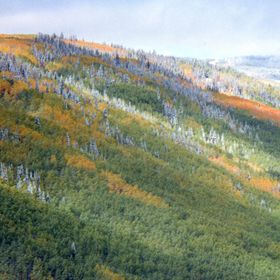"Fins" of pumice-formed tuff, modified by slippage along a fault. Plaza Blanca, New Mexico
"Fins" of pumice-formed tuff, modified by slippage along a fault. Plaza Blanca, New Mexico
Read less
Read less
Views
170
Likes
Awards
Contender in the Photography Awards
Curator's Selection
Summer 2020
Peer Award
Superb Composition
Absolute Masterpiece
Top Choice
Superior Skill
Genius
Outstanding Creativity
Top Ranks
Categories
Same photographer See allBehind The Lens
Discover more photos See all
Behind The Lens
Location
This was taken in northern New Mexico, near the well-known town of Abiquiu, at a location known as Plaza Blanca. This is an area of eroded formations of soft white stone, represented in several works by Georgia O'Keefe. However, this slip-fault is at one end, where the rock layers have been both upturned and hardened by heat and friction.Time
This was at moonrise (sunset) on the day before the full moon.Lighting
The lighting problem with moonrise shots is that if the sun is still in the sky, the sky is blue and the moon is a washed-out white. After sunset, the sky will darken and the moon will be a nice yellow. But then, the full moon will be in full sun, while the foreground will be fairly dark. I have tried without success to bracket exposures, then combine with HDR (High Dynamic Range). I the solution I arrived at is to bracket exposures (usually +- 2.3 stops, with a exposure compensation of -1.6), then take a middle-range shot, where I can both lighten the foreground and decrease moon exposure. The day before the full moon is usually better for getting light on the foreground, and the sun is 95% or more full.Equipment
I use a full-frame Pentax K-1ii. For moon shots, I use a Sigma 70-300 zoom, here at 170 mm. I use a very old Slik U-212 tripod, though I have mounted a newer 3-way pan/tilt head. I usually try to get a significant fore- and middle-ground, to put the moon in context; so flash does not help my lighting problem. I usually use a small 3-way bubble level in the flash shoe of my camera. It's always full dark when I finish, so of course headlamps and flashlights. For moon shots, I like to use a moderate telephoto. This increases the size of the moon, making it more important in the frame. If the earth-bound features are far away, their magnification is not as significant.Inspiration
Since retirement, I have assigned myself to shoot the full moon every month - usually moonrise, but sometimes moonset. As a landscape & nature photographer, I don't shoot just the moon (that's astrophotography). I like to shoot the moon in the context of the landscape. Since I live in northern New Mexico, there are plenty of landscape features to use - mountain ranges, individual peaks, and sometimes, as here, rock formations. I had been at this location many times during the day, and had seen only rocks. The "jaws of a rock monster" aspect was a surprise to me, noticed only when the rocks were seen in silhouette. So, pure luck.Editing
I nearly always need to do a little cropping. For this shot, as noted above, balancing the moon vs. foreground exposures was the main problem here. So in Lightroom I used the exposure, highlights, shadows, and black sliders; sometimes I need to use the tone curve controls. If the moon is still too bright, I can in the HSL panel lower the luminance in the yellow band. I almost always add some clarity; it can bring out details in both the moon and the foreground, and clouds if there are any. If I ever master Photoshop, I will probably be able to do all of that better.In my camera bag
Pentax full-frame (K-1ii) and crop-sensor (K-50) cameras. On each, I keep an all-purpose zoom (18-135mm, 28-200mm) for grab-shots. Then 28mm, 50mm, 200mm, 70-300mm, and 100mm macro lenses. Extra batteries, UV and polarizing filters, and filter wrenches. Tripod and electronic cable release. I don't use flash, but I carry some collapsible reflectors which also serve as windbreaks or background for wildflowers.Feedback
Full moon photography, as noted above, is a critical balance between moon brightness and foreground dimness. And the ideal case is rare - while sunset or sunrise times change only a minute or two from day to day, moonrise and moonset change an hour from day to day. I plan my full moon shots in advance using The Photographer's Ephemeris, a Web application. In essence, I use TPE to map the peak or rock formation I want in the fore- or middle-ground, then where the full moon will be rising above the visible horizon, and draw a line from the moon through the point of interest, and extend it away from the moon. That will provide a line, along which the camera position should be located. BTW - even in arid New Mexico, at least 1/3 of the time, clouds or other weather keeps me from shooting the full moon. And coming back the next day doesn't work, because the moon will rise an hour later. But on several such occasions, I've gotten good shots of landscapes in stormy weather.





















![March 1, 2018. This was my first effort to line up this shot using The Photographer's Ephemeris [Web app - thephotographersephemeris.com]. Appare](https://cdnpt01.viewbug.com/media/mediafiles/2018/03/05/77818511_widepreview400.webp)

























